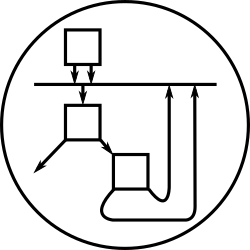Network server programming with SML/NJ and CML
This page is a mirrored copy of an article originally posted on the (now sadly defunct) LShift blog; see the archive index here.
Fri, 1 January 2010
My experience with SML/NJ has been almost uniformly positive, over the years. We used it extensively in a previous project to write a compiler (targeting the .NET CLR) for a pi-calculus-based language, and it was fantastic. One drawback with it, though, is the lack of documentation. Finding out how to (a) compile for and (b) use CML takes real stamina. I’ve only just now, after several hours poring over webpages, mailing lists, and library source code, gotten to the point where I have a running socket server.
Download source code, building, and running
The following example is comprised of a .cm file for building the program, and the .sml file itself. The complete sources:
Running the following command compiles the project:
ml-build test.cm Testprog.main
The ml-build output is a heap file, with a file extension dependent on your architecture and operating system. For me, right now, it produces test.x86-darwin. To run the program:
sml @SMLload=test.x86-darwin
substituting the name of your ml-build-produced heap file as necessary.
On Ubuntu, you will need to have run apt-get install smlnj libcml-smlnj libcmlutil-smlnj to ensure both SML/NJ and CML are present on your system.
The build control file
The test.cm file contains
Group is
$cml/basis.cm
$cml/cml.cm
$cml-lib/smlnj-lib.cm
test.sml
which instructs the build system to use the CML variants of the basis and the standard SML/NJ library, as well as the core CML library itself and the source code of our program. For more information about the SML CM build control system, see here.
The example source code
Turning to test.sml now, we first declare the ML structure (module) we’ll be constructing. The structure name is also part of one of the command-line arguments to ml-build above, telling it which function to use as the main function for the program.
structure Testprog = struct
Next, we bring the contents of the TextIO module into scope. This is necessary in order to use the print function with CML; if we use the standard version of print, the output is unreliable. The special CML variant is needed. We also declare a local alias SU for the global SockUtil structure.
open TextIO
structure SU = SockUtil
ML programs end up being written upside down, in a sense, because function definitions need to precede their use (unless mutually-recursive definitions are used). For this reason, the next chunk is connMain, the function called in a new lightweight thread when an inbound TCP connection has been accepted. Here, it simply prints out a countdown from 10 over the course of the next five seconds or so, before closing the socket. Multiple connections end up running connMain in independent threads of control, leading automatically to the natural and obvious interleaving of outputs on concurrent connections.
fun connMain s =
let fun count 0 = SU.sendStr (s, "Bye!\r\n")
| count n = (SU.sendStr (s, "Hello " ^ (Int.toString n) ^ "\r\n");
CML.sync (CML.timeOutEvt (Time.fromReal 0.5));
count (n - 1))
in
count 10;
print "Closing the connection.\n";
Socket.close s
end
The function that depends on connMain is the accept loop, which repeatedly accepts a connection and spawns a connection thread for it.
fun acceptLoop server_sock =
let val (s, _) = Socket.accept server_sock
in
print "Accepted a connection.\n";
CML.spawn (fn () => connMain(s));
acceptLoop server_sock
end
The next function is the primordial CML thread, responsible for creating the TCP server socket and entering the accept loop. We set SO_REUSEADDR on the socket, listen on port 8989 with a connection backlog of 5, and enter the accept loop.
fun cml_main (program_name, arglist) =
let val s = INetSock.TCP.socket()
in
Socket.Ctl.setREUSEADDR (s, true);
Socket.bind(s, INetSock.any 8989);
Socket.listen(s, 5);
print "Entering accept loop...\n";
acceptLoop s
end
Finally, the function we told ml-build to use as the main entry point of the program. The only thing we do here is disable SIGPIPE (otherwise we get rudely killed if a remote client’s socket closes!) and start CML’s scheduler running with a primordial thread function. When the scheduler decides that everything is over and the program is complete, it returns control to us. (The lone end closes the struct definition way back at the top of the file.)
fun main (program_name, arglist) =
(UnixSignals.setHandler (UnixSignals.sigPIPE, UnixSignals.IGNORE);
RunCML.doit (fn () => cml_main(program_name, arglist), NONE);
OS.Process.success)
end
Comments
On 16 April, 2010 at 4:39 am, wrote:
On 8 September, 2010 at 3:25 am, wrote:
Thanks - this was very informative. I don’t believe that you need the arch/os suffix when specifying the heapfile argument to sml.

Thanks! I just started going through Reppy’s Concurrent Programming in ML, and your instructions are extremely useful in testing the sample programs